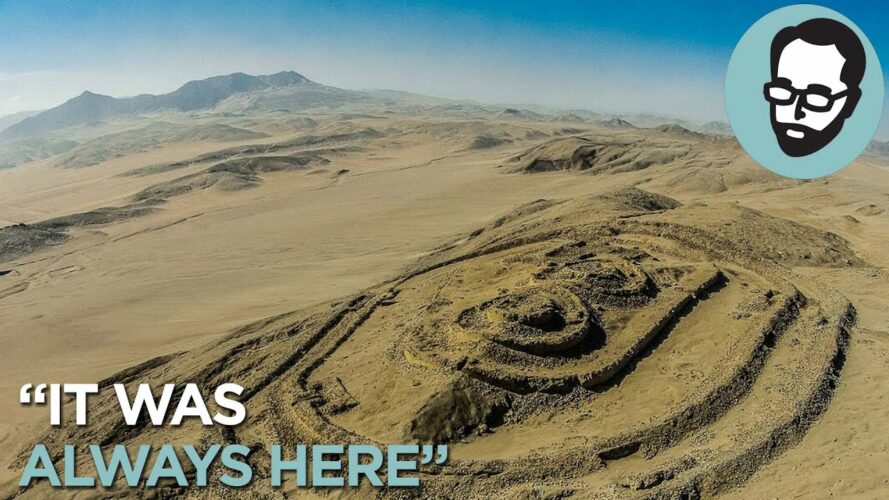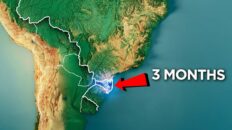The Chankillo Archeoastronomical Complex is an ancient solar observatory in Peru that was built thousands of years before the Inca civilization ruled the area. Very little is known about the actual culture who built this ingenious structure, but we know they were far more advanced than we ever expected.
TRANSCRIPT:
This is not an infinity symbol. It looks like one. But it’s not. It does kinda represent the same thing, though.
This is known as an analemma. This is the shape that the sun takes across the sky if you were to take a picture at the same time every day. As this time lapse shows.
The sun’s position changes due to the Earth’s axial tilt and elliptical orbit around the sun. The same reason days are shorter in the winter and longer in the summer.
And people have been plotting the sun’s position in the sky as far back as there have been people. It determined the times for planting and harvesting crops, hunting seasons, migration patterns, and a myriad other important cultural purposes.
This is especially true if the culture in question worships the sun like a god, of which there were many, all around the world. Like the ancient Egyptians, the Nabateans, the Shintos of Japan, and the Incas in Peru.
But before the Incas there was another culture, completely lost to time, who built a solar observatory that pre-dates the Incas by a thousand years.
The idea that an ancient culture believed the sun was a god. It’s simultaneously weird and obvious. For the most part when we think about people looking to the sky for omens and mythology, we think of the night sky.
Like we have a litany of constellations representing various mythological characters and creatures going way back to ancient times.
The Greeks thought the milky way was actually the milk of Hera, and their constellations – which they called asterisms – helped them do everything from keep time to planting and harvesting food, to when to sacrifice humans, like you do.
Of course those constellations meant different things to different cultures. To the Greeks Scorpio looked like a scorpion. Hence the name Scorpio.
But to the Maori in New Zealand, that same set of stars looked like Maui’s Fish Hook, which he used to lift the Northern Island of New Zealand out of the ocean.
The Pleiades were known to many different cultures because it was a bright, distinct cluster of stars. and then of course there’s the moon.
Fishermen would use the Moon to predict tides and the best times to fish and in many cultures was used to track women’s menstruation.
Imagine believing that the moon physically affected your body in some way. Like you’re a werewolf or something.
The stars gave the Polynesian culture the ability to navigate long distances across the ocean, they helped slaves in the US escape north by following the North Star, and Mayan kings synchronized their ascension rituals to the position of the stars and planetary alignments in order to secure their divinity.
So yeah the night sky had its devotees.
But the sun had its own following. And obviously it did, it’s what takes away all those important stars every day.
One of the cultures that seemed to be very involved with the Sun and sky was the Incan Empire.
It played a huge role in their selection of leaders, and the royal family, and they constructed their temples and cities to take advantage of this.
For example when the sun lines up with your palace it can give that ruler the illusion of control of the heavens, making them gods on Earth.
By the way, “Inca” wasn’t their real name. What they actually called themselves were the Tawantinsuyu, which meant “Realm of the Four Parts”
The “Inka” with a “k” was the name of their ruler, who was a god-king much like an Egyptian pharaoh. They were carried everywhere and never allowed to touch the ground. And dead Inkas were worshipped and treated as if they were still alive.
It was when the Spanish came that they decided to call the entire civilization the “Incas.” Which would be like calling the entire Egyptian civilization the Pharaohs.
Whatever they went by, they were the most powerful and largest empire in the pre-columbian Americas. And sun worship was a big part of their culture.
But they didn’t create their worship of the sun. They got that from someone else. The thing is, we have no idea who those people were.
But we know they existed because of what they left behind. A series of ancient archeological buildings that are arguably one of the greatest scientific finds of our generation, and you likely have never heard about it.
It’s called the Chankillo Archaeoastronomical Complex. Which is a mouthful but it’s awesome.
The complex features a series of towers and fortified structures built between the 9th and 12th centuries.
These towers have intrigued researchers for years because of their unique astronomical alignment, which makes them a simple but surprisingly accurate solar calendar.
Its main feature is a series of 13 towers arranged in a straight line on the top of a hill aligned north/south. They vary in height but the tallest tower is over 30 meters tall.
And that’s 30 meters tall now with 1000 years of decay. They may have been taller back then.
But here’s the really cool part.
On both the west and east sides of the hill are observation points where you can observe the sun rising and falling over the towers. Sunrise from the west observation point, sunset from the east.
And depending on where the sun falls amongst those towers, you can gauge the day of the year with accuracy down to 2 or 3 days.
It starts with the winter solstice, which is June 21st in the southern hemisphere. This aligns with the left side of the first tower also on the far left side of the hill. As the sun moves through the notches and ridges, it corresponds to various dates.Ending on the opposite side of the last tower on December 21st, their summer solstice.
July 31st, Aug 12th, Aug 23rd, Sept 2nd, Sept 11th, Sep 22nd SPRING EQUINOX , Oct 1st, Oct 11th, Oct 20th, Oct 30th, Nov 12th, Nov 28th
Dec 21st SUMMER SOLSTICE
And then those same 13 ridges now work in reverse, moving through January and March, reaching the Fall Equinox about halfway, and ending back where it stared on June 21st, the Winter Solstice.
Jan 10th, Jan 27th, Feb 9th, Feb 19th, Mar 1st, Mar 11th, Mar 20th FALL EQUINOX, Mar 31st, April 10th, April 20th, May 2nd, May 14th, June 21st WINTER SOLSTICE
Through this system, the people who built Chankillo were able to track the solstices and use this information to mark the changing of the seasons.
In addition to the towers, the site also contains several other structures, including a walled courtyard, small buildings, and tombs.
These structures suggest that Chankillo was not just an astronomical complex or a giant calendar, but also served as a religious and political center.
Archeologists believe Chankillo was used for a variety of purposes, like for agriculture, allowing them to know when to plant and harvest their crops.
Another theory is that Chankillo was used for religious and spiritual purposes. That the alignment of the towers with the sun would have been seen as a sacred connection to the forces of nature, spawning various religious ceremonies and rituals.
Finally, some researchers believe that Chankillo served as a political and military center. This is based on the fact that some of the buildings were heavily fortified, including one structure that’s become known as the Fortified Towers.
The Fortified Towers are clearly a defensive structure, banded with many layered walls with false entrances at the top of a hill. It’s possible that important people, rituals, or information were kept there.
Inside the fortification are two circular north and south towers that are identical from what we can tell.
And near the towers is another lower structure with a long hallway that would take the ancient scientist to the observation area on the west side of the solar calendar.
Since it’s thought that the fortification was home to important leaders and scientists or astronomers, they suspect that the western observation area was restricted for political and intellectual elites.
These people got to watch the sun rise through the towers.
Consequently, it’s thought that the eastern observation area was set up for the commoners to gather and watch the sun set over the towers, possibly involving ceremonies and celebrations, like a big tailgating party.
But since they probably worshipped the sun, I guess it would be like tailgating at church.
In all seriousness, this was their way of communing with their god. Probably a big deal.
I’m just assuming that, of course, what do we actually know about the people who built Chankillo?
Unfortunately, not much. But it’s thought that they had a highly organized and complex social structure based off the buildings they left behind.
For example, the towers were made of adobe, a type of clay-based building material, and would have required a significant amount of labor and resources to construct.
They’ve been named the Sechín culture, or the Casma-Sechín culture, because they lived in the Casma Valley of Peru.
And Chankillo isn’t the only thing they build, in fact, they built a LOT of architectural complexes.
Like the the Sechín Alto Complex, which contained one of the largest plazas in South America at the time.
The site (as we know it) was abandoned long before the arrival of the Spanish conquistadors, and even the Incas claimed to not know who built it.
They also built Sechin Bajo frieze, considered the oldest monumental architecture in the Americas.
Also sites like Cerro Sechin, Mojeque(Pampa de las Llamas-Moxeke), and Taukachi-Konkan, as well as other smaller sites.
Many of these places are considered on the same level of sophistication as Egyptian architecture. In fact, early archeologists speculated that they were actually built by the Egyptians, that they traveled to South America somehow.
They didn’t. But you kinda can’t blame them for thinking that, especially considering some of these go back to 3600 BCE.
The people themselves however go back way further than that. The earliest radiocarbon date indicating human habitation is 7600 BCE found at Cerro Sechin.
That’s a crazy long time ago. It’s such a long time span, it’s possible several cultures may have built these over time.
The crazy thing too is that this wasn’t millions of people, more like 15,000 to 23,000 people. They probably couldn’t grow much larger because of the lack of water in the region.
The Sechín Valley is one of the driest places in Peru, with less than one inch of rain a year.
Which means they likely depended heavily on river valleys and flood cycles, again… not much unlike the Egyptians.
Both cultures that arose in arid places that required a lot of ingenuity to survive.
Oh, and one more way they were like the ancient Egyptians, is they eventually ended.
It’s thought that it wasn’t a slow decline either, but more likely they were done in by invaders.
The archeological record shows that sudden cultural changes occurred that mirrored the highland Chavin culture.
The architecture became more rigid and military and their culture assimilated into another. But what remains from the height of their culture – the marriage of sociology, engineering, astronomy, mathematics, and religion – that remained to this day.
These were people who looked up to the stars with the same eyes that we do and felt the same fears and anxieties we have today.
Well, maybe not exactly the same, they didn’t have social media.
To them, Chankillo was a connection to the infinite. The endless celestial cycle going back to the beginning of time, carrying with it wisdom they could hardly imagine.
And it serves a similar purpose to us, connecting us to an ancient history that far preceded us. And can’t help but make you think about what we’re going to leave behind. And how we’ll be remembered.




Add comment